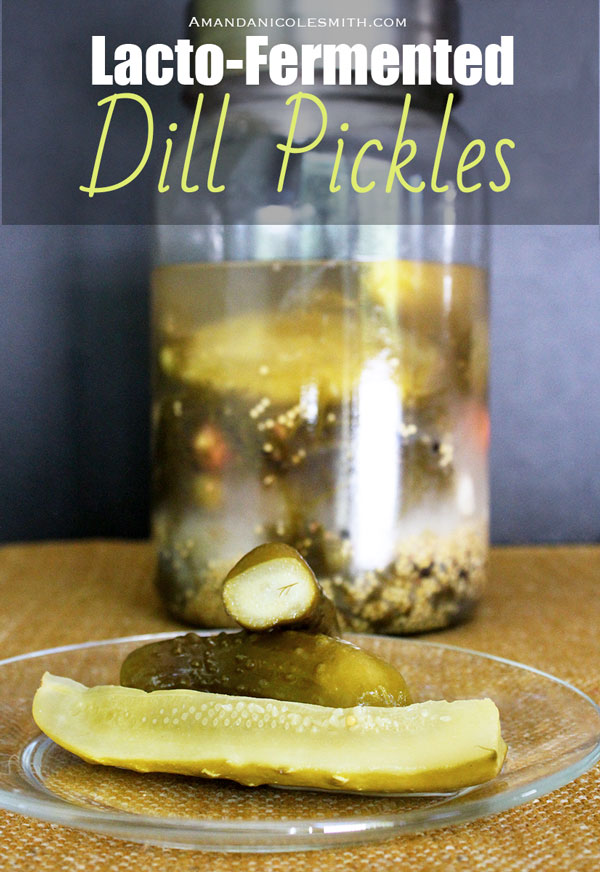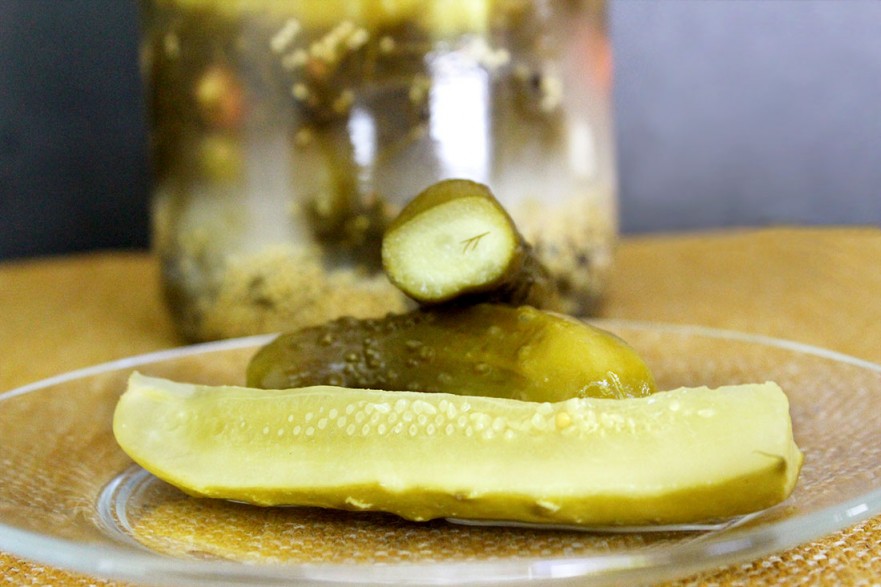Crisp and crunchy sour dill pickles, lacto-fermented in a salt brine with spices and herbs. In the end these pickles will be loaded with beneficial probiotic, lactobacillus, hence the name lacto-fermented.
Probiotic pills/capsules can get expensive. Making your own fermented foods is much cheaper, and lacto-fermented pickles have 100 times more probiotics than a pill!
I started making pickles in 2012, shortly after going completely raw vegan. I was in full detox mode, as I had been filling my body with processed food my entire life, and my gut was in bad shape. Creating dishes that were familiar to the ones I ate growing up, helped me get through this incredibly challenging experience.
Pickles have always been amongst my favorite snacks, every time I eat them I can’t help but to sing the Little Rascal’s “pickle song”…” I got two pickles hey hey hey!” I’m such a dork. 😛
At first the task of fermenting seemed daunting, to say the least; but after buying the book “The Art of Fermentation” I gradually came to understand… well… the art of fermentation. There are many different fermenting techniques and flavors to accompany the dill, today I will be showing you a basic recipe with basic fermenting techniques, and from their you can choose to use different spices and herbs to suit your preference.

How to Pick The Right Pickling Cucumbers
Buy Them From The Farmers!
I always buy my pickling cucumbers at the farmers market for two major reasons:
- They’re Fresh. Farmer’s usually pick their produce a day or two before the farmers market, which means they are extremely fresh. The fresher the crisper your pickles will be, and who doesn’t like a good crunchy pickle?
- They’re Cheaper. Farmer’s sell pickling cucumbers in bulk. At almost every farmers market I have been to in rural and urban markets, I normally see pickling cucumbers in 1/2 peck wooden baskets filled to the top for less than $9. That would make about a gallon of pickles! All in all with the spices, cucumbers, sea salt and a carrot you’re looking at about $13 for a gallon pickles with about 100 times more probiotics than an expensive probiotic pill/capsule.
Pick The Smallest and Wartiest of Them All
The smaller pickling cucumbers have warts, if the pickle is turning yellow and does not have warts, it means it is over ripened and probably has more seeds than preferred.

How to Keep Pickles Crisp
There are three prominent techniques I like to use, to ensure crispy pickles.
- Soak the cucumbers in ice water for about 30 minutes to an hour before jarring.
- Cut the blossom ends off.
- Put a carrot in the ferment.

How To Ferment Pickles
Here are a few things to know about fermenting pickles.
- All you need is a mason jar with a metal lid and band or an air-lock.
- The jar needs to be sanitized, this is best done with a dishwasher. As an extra precaution, I’ll boil water and swish it around in the jar for about 20 seconds before pouring it out. If you don’t have a dishwasher you should boil the jar in a large pot filled halfway with water, for about 5 minutes.
- The amount of salt you add to the water for the brine makes a big difference.
- 2-3 tbsp salt per quart is the standard.
- Too little salt could result in spoilage.
- More than enough salt will result in a tangier pickle and will take longer to ferment.
- Too much salt will inhibit lactic acid bacteria growth, thus preventing fermentation.
- When and where you ferment makes a big difference.
- In my experience, fermenting during a full moon will result in quicker fermentation; this is up for debate. If you’re using a regular mason jar lid you may need to release some of the carbon dioxide to prevent an explosion. Check the lid by pressing the center, if the lid is too firm to press down, slightly open the lid to release the pressure.
- The higher the altitude, the longer your ferment will take. If you live at 6000 feet you will notice significantly longer ferment times. Accordingly, someone at 0 feet will experience shorter ferment times.
- The hotter the area you ferment, the faster it will go. The perfect fermenting temperature is about 70-75 degrees. If it is too cold, wrap the jar in a kitchen towel like a baby 😉
- Pack everything tightly into the jar and make sure nothing comes above the brine.
- I like to quarter a few pickles longways, to use at the top as a barrier. They are flexible so you can usually wedge them in the top of the jar and nothing will budge. Plus when you quarter them, it’s easier to taste test their doneness.

When Are The Pickles Done?
- Look for transparency. Finished pickles are translucent and a darker, paler shade of green. The “after” pickles in the picture above could use a few more days to ferment those dark green spots.
- Notice the pressure. Look for the active bubbles shooting to the top, check the pressure of the lid, relieve pressure if needed. Normally when the rate of bubbles racing to the top has slowed I move on to number 3.
- Taste the pickles. If you like how they taste, put them in the refrigerator to finish off. After being in the refrigerator for at least a day, the yeasty flavor should dissipate.
Why Are My Pickles Cloudy?
- Lactic acid bacteria, aka lactobacillus produces a naturally occurring white sediment, too much lactic acid and the brine will turn cloudy.
- Using tap water or table salt can also result in a cloudy brine. Try using purified water and celtic sea salt for the best results.
- Old cucumbers can also turn the brine cloudy and can result in spoilage. Which is why I always suggest buying them from the farmers.
- When the pickles are actively fermenting, carbon dioxide, a by-product of lactobacillus; will force the sediment all around giving a cloudy appearance. When fermentation is over, or you put it in the fridge, the sediment will settle to the bottom.
Learn more about why your pickle brine is cloudy.
Mold
If you see or smell any mold, toss it. I would not suggest only throwing away the infected area, I would toss the whole thing, and start again.
Mold can occur from any of the following:
- Jar wasn’t clean enough.
- Not enough salt wast used.
- Cucumbers were not fresh
- Tap water and table salt were used.
- Air was present during fermentation.
- Pickles started coming up above the brine.
Lacto-Fermented Dill Pickles
INGREDIENTS
- Enough small pickling cucumbers to pack a quart sized jar tight; aprox. 5
- 1 cup dill; -or- 2 tbsp dill seed
- 3 cloves garlic
- 1 small carrot; sliced
- 2 tbsp pickling spices
Brine
- 2-3 cups purified water
- 2-3 tbsp celtic sea salt
Pickling Spices
- 1 tsp mustard seed
- 1 tsp peppercorn
- 1 tsp coriander
- 1 tsp celery seed
- 1/2 tsp allspice
- 2 whole bay leafs; dried
- 1 whole clove
INSTRUCTIONS
- Optional* Put the cucumbers in a baking dish and pour ice on top, with a little water and let sit for 30 minutes up to an hour.
- Heat up the water just enough to dissolve the salt and set aside.
- Optional* Cut off the blossom ends of the cucumbers.
- Get a clean jar that has been run through the dishwasher, or boil the jar for 5 minutes.
- Pour all the spices at the bottom of the jar.
- Squeeze in a few cucumbers.
- Fill the gaps with carrots, dill and garlic.
- To make sure the pickles do not come above the brine, quarter the cucumbers lengthwise and wedge them in, laying flat.
- Add the brine.
- Put a metal lid on top and set aside in a cool dark place around 70-75 degrees F.
- Check for pressure, relieving when necessary.
- 1-4 weeks later, when the pickles have turned a pale green, and you like the way they taste; store them in the refrigerator.
NOTES
Pickles will store in the fridge for at least 4 months if fermented correctly. Although I always recommend eating them within the first few months.


Comments 7
Author
It has come to my attention that I made a mistake cutting off the stem side of the cucumbers in the pictures, rather than the blossom end. The good news is, my pickles were still crunchy regardless. I would say if you really have problems with your pickles going soft, do it as an extra precaution, otherwise I’m going to mark that as optional!
1 cup of dill? A full cup? Dill weed or seed?
Do you use pickling spice as well as all the spices you list or is the list to make your own pickling spice? Thanks for your help Amanda.
Author
1 cup fresh dill weed, measured loosely including the stem, or 2 tbsp dried dill seed.
That is just a list to make your own pickling spice.
You are so very welcome! I hope your pickles turn out fabulous 🙂
Happy Pickling!
You can also add some fresh horseradish and garlic. This kind of pickles are known in Poland as ogorki kiszone 🙂 http://neveradulldayinpoland.com/time-to-cook-pickled-cucumbers-ogorki-kiszone/
Author
I try to like horseradish, I just can’t seem to adapt my tastebuds yet 😉 I’ll have to try it again, thanks for sharing the recipe!
My pickles are in my fermenting crock. I’ll be back in a few weeks with an update. Thanks again for taking the time to put this recipe online and posting it in Wild Fermentation facebook.
Author
Hurray, I look forward to hearing how they turn out! 🙂 Also you’re welcome, thank you for taking the time to read and comment.